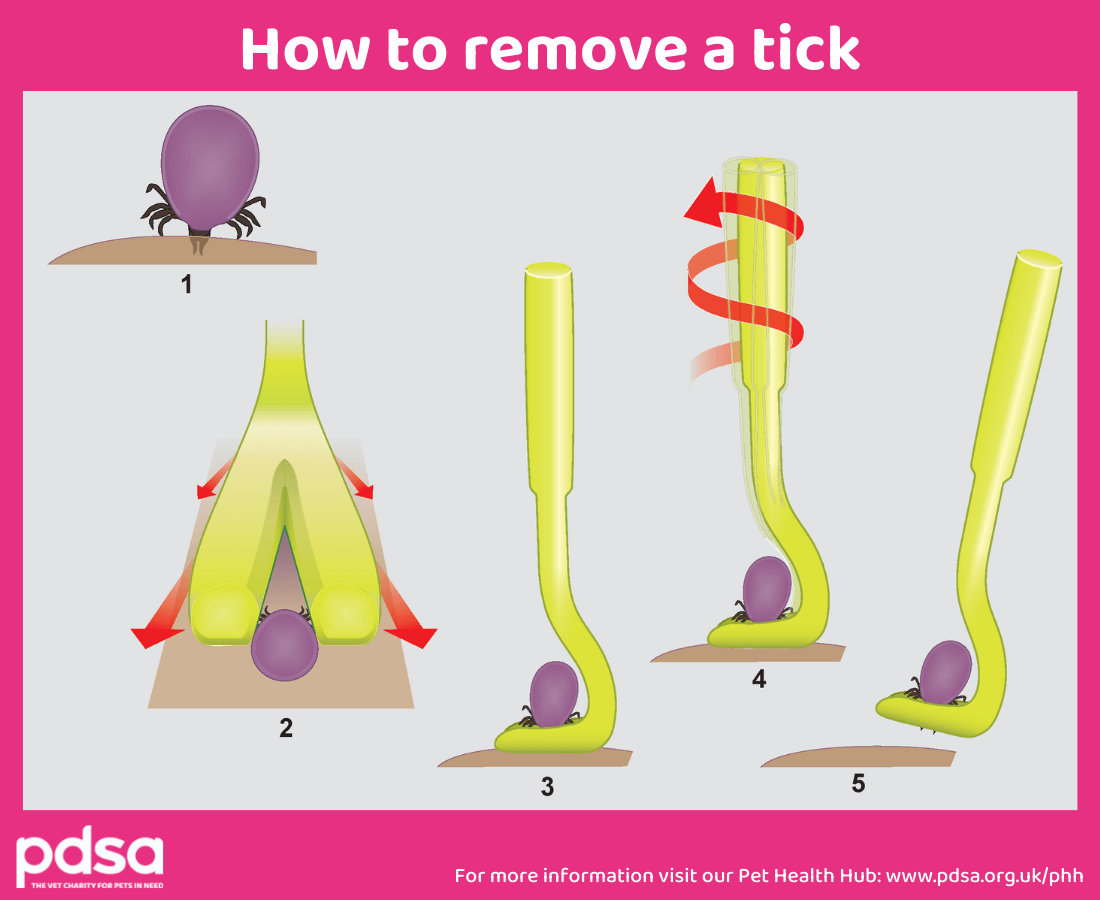How To Remove a Tick From A Dog Or Cat
Overview
- It’s important to remove ticks carefully, and with the right equipment, so no part of it gets left behind.
- It’s also important to remove them as soon as you notice them, to reduce the risk of transmitting diseases such as Lyme disease.
- Never remove a tick by pulling, crushing, or squeezing it.
 Video found at youtu.be/sGDN5IAyngA
Video found at youtu.be/sGDN5IAyngA

Step 1 – Slide a tick remover under the tick
- Slide a tick-twisting tool under the tick, as close to your pet’s skin as possible.
- If the tool doesn’t fit neatly, use a different size (they usually come in packs of 2 or 3 different sizes).
- If you can’t get hold of a tick twisting tool, you can use ordinary tweezers, or a homemade remover (a slightly different removal method*) - just be very careful to hold the tick gently and as close to the skin as possible.
Step 2 – Twist the tick
- Without pulling upwards, twist the tool in one direction until you feel the tick loosen – it will let go when you’ve turned enough.
Step 3 – Remove the tick
- Slowly lift the tool away from your pet; the tick should release and stay in the hook.
- Get rid of it to ensure it doesn’t attach to other people or animals.
Step 4 – Clean the area
- Clean the affected area with warm salty water, and monitor your pet for any signs of illness (such as redness, heat around the bite site, lethargy, or a reduced appetite).
If you’re worried about removing the tick yourself, ask your vet practice for help.
- How can I tell if a tick head is still in my dog’s skin?
- How can I tell if my dog has an infection around their tick bite?
- How can I remove a tick without tweezers?
- How to make a homemade tick remover
- Can ticks transmit Lyme disease?
How can I tell if a tick head is still in my dog’s skin?
If you remove a tick by pulling, crushing, or squeezing it, you might cause it to break apart and leave mouthparts behind in your dog’s skin. If this is the case, you will be able to see a small black spot where the tick was attached, and possibly some redness and swelling. If part of the tick is left behind, there is a risk that your dog might develop an infection, so it’s best to book in for a vet check.
How can I tell if my dog has an infection around their tick bite?
If your dog has a tick bite infection, they are likely to develop heat, redness, swelling, and possibly some discharge from where the tick was attached.
How can I remove a tick without tweezers?
Although it may be tempting to try removing a tick without the proper equipment, it is always best to take you time to find something that will remove it properly, even if this means delaying by an hour or two. Ask friends and family if they have a tick twisting tool, make a homemade tick remover (see below), or as a last resort, you can use ordinary tweezers – but be very careful to hold the tick gently, and as close to the skin as possible.
How to make a homemade tick remover
If you don’t have a tick remover, you can make a simple tool at home using some rigid card or an old credit card and some scissors. Simply cut a narrow triangular wedge out of one corner of the card and push it underneath the tick, as close to your pet’s skin as possible. Gently push the tick in one direction, until your feel it loosen, at which point you can remove it.
Can ticks transmit Lyme disease?
Yes, some ticks in the UK carry and transmit Lyme disease.
Published: July 2022
Did you find this page useful?
Tell us more
Please note, our vets and nurses are unable to respond to questions via this form. If you are concerned about your pet’s health, please contact your vet directly.
Thank you for your feedback
Want to hear more about PDSA and get pet care tips from our vet experts?
Sign up to our e-newsletter
Written by vets and vet nurses. This advice is for UK pets only. Illustrations by Samantha Elmhurst.

